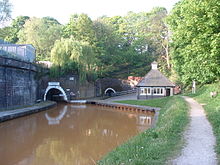 Northern end of Telford's Harecastle Tunnel (left) next to the disused Brindley tunnel (right). | |
| Overview | |
|---|---|
| Location | Kidsgrove to Tunstall, Staffordshire, England |
| Coordinates | 53°4′27″N 2°14′11″W / 53.07417°N 2.23639°W |
| OS grid reference | SJ843529 |
| Status | Open |
| Waterway | Trent and Mersey Canal |
| Start | 53°3′46.62″N 2°13′35.64″W / 53.0629500°N 2.2265667°W (Southern Portal) |
| End | 53°5′4.44″N 2°14′39.24″W / 53.0845667°N 2.2442333°W (Northern Portal) |
| Operation | |
| Constructed | 1824–1827 |
| Owner | Canal & River Trust |
| Technical | |
| Design engineer | Thomas Telford |
| Length | 2,675 metres (2,926 yards) |
| Towpath | No (removed) |
| Boat-passable | Yes |
Harecastle Tunnel is a canal tunnel on the Trent and Mersey Canal in Staffordshire between Kidsgrove and Tunstall. The tunnel, which is 1.6 mi (2.6 km) long, was once one of the longest in the country. Its industrial purpose was for the transport of coal to the kilns in the Staffordshire Potteries. The canal runs under the 195 m (640 ft) Harecastle Hill near Goldenhill, the highest district in Stoke-on-Trent.[1]
Although described singularly as a tunnel, Harecastle is actually two separate but parallel tunnels built almost 50 years apart. The first was constructed by James Brindley in the late 18th century and the second larger tunnel was designed by Thomas Telford, and opened in the late 1820s.
Only the Telford tunnel remains navigable after a partial collapse closed the Brindley tunnel shortly before the First World War. As the Telford tunnel is only wide enough for a single boat, canal traffic is managed by sending alternating northbound and southbound groups of boats through the tunnel. Ventilation is provided by large electric fans at the south portal.
- ^ 'Tunstall', in A History of the County of Stafford: Volume 8, ed. J G Jenkins (London, 1963), pp. 81-104. British History Online, accessed 21 September 2016.